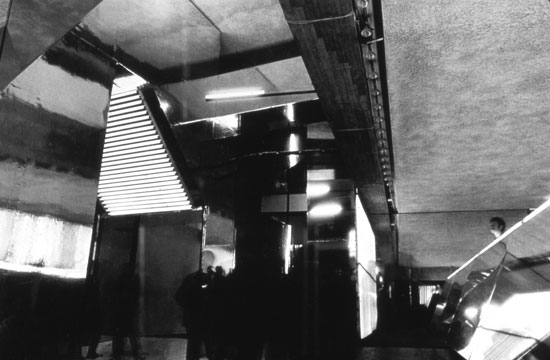Charles Moore, “Departmental Reports: Department of Architecture,” Eye: Magazine of the Yale Arts Association, 1967, 29.
When this research was initially undertaken it was not with the idea of writing on the Yale A&A as such, but in the context of understanding the school during the moment when the Australian architect Peter Corrigan was studying there.
See Richard W. Hayes, “Activism in Appalachia: Yale Architecture Students in Kentucky, 1966–69,” in Agency: Working with Uncertain Architectures, ed. Florian Kossak, Doina Petrescu, Renata Tyszczuk, Tatjana Schneideer, and Stephen Walker (New York and London: Routledge, 2010), 21–31. Hayes recalls the importance of the initiative of three students—Tom Carey, Steve Edwins, and Robert Swenson—who had spent time in Appalachia and introduced the project in New Zion, Kentucky “as a possible extracurricular project to Moore, who instead decided that he would make it the design project for the Spring 1967 semester of the first-year class,” teaching it along with Kent Bloomer, 26. See also “Out of the Atelier and Into Reality,” Progressive Architecture XLVIII, no. 9 (September 1967): 166.
“Education for Alienation,” Novum Organum 1 (November 14, 1968): np. The editors were Bob Coombs, Mark Ellis, Manfred Ibel, Herb Short, and Stuart Wrede.
Brochure entitled “Yale University School of Art and Architecture,” 1968–69, np.
See “Computer Graphics in Architecture: Proceedings of the Yale Conference on Computer Graphics in Architecture,” ed. Murray Milne, (Computer Graphics and Architecture, Yale University, 1968).
Charles W. Moore, “Plug it in Ramses, and See if it Lights Up, Because We Aren’t Going to Keep It Unless it Works,” Perspecta 11 (Fall 1967): 32–43.
C. Ray Smith, Supermannerism: New Attitudes in Post-Modern Architecture (New York: E. P. Dutton, 1977), 108–09.
Ada Louise Huxtable, “Kicked a Building Lately?” New York Times, January 12, 1969, 25, 28.
On Pulsa see Yates McKee, “The Public Sensoriums of Pulsa: Cybernetic Abstraction and the Biopolitics of Urban Survival,” Art Journal 67, no. 3 (Fall 2008): 46–67.
Smith, Supermannerism, 108–109.
Thomas Hine and John Coots, “Light, Sound, People Make ‘Argus’ Happen,” Yale Daily News, April 26, 1968, 1. It is not clear whom they are citing.
William Betsch, “Panoptics Fill Yale Gallery,” New Haven Journal-Courier, April 11, 1968.
Hine and Coots, “Light, Sound, People Make ‘Argus’ Happen,” 1.
Joel Katz, “Pulsa=Light as Truth,” Yale Alumni Magazine XXXI, no. 8 (May 1968): 43.
Cited in Stewart Kranz, Science & Technology in the Arts: A Tour Through the Realm of Science + Art (New York: Van Nostrand Reinhold, 1974), 261.
Cited in Kranz, 262.
Gerd Stern, cited in Deckle McLean, “The Multi-Media Thing,” Boston Sunday Globe, February 7 1971.
See Marshall McLuhan, “The Emperor’s Old Clothes,” in The Man-Made Object, ed. Gyorgy Kepes (New York: George Braziller, 1966), 90–95.
See Plastic as Plastic, ed. Sandra R. Zimmerman (New York: Museum of Contemporary Crafts, 1968).
William Borders, “Yale Students Mold an Experimental House of Plastic Foam,” New York Times, June 16, 1968, R1. Drury later realized such a foam-plastic structure as a corporate guest house for the West Point Pepperell corporate headquarters in Langdale, Alabama, using a heavy nylon fabric manufactured by the corporation. See Felix Drury, “Foam Home,” Progressive Architecture 52 (May 1971): 100–03.
Manfred Ibel, “Experimental Houses for Squirrels,” Novum Organum (December 3, 1968): np.
See C. Ray Smith, “The New Interiors: Fad or Fact?” Progressive Architecture 49, no. 4 (October 1968): 150-58.
Ada Louise Huxtable, “Kicked a Building Lately?” 28.
Ibid.
Henry Stone, “Walkout,” Novum Organum 1 (1968), np. See also Perspecta 29 and Brian Goldstein, “Planning’s End? Urban Renewal in New Haven, the Yale School of Art and Architecture, and the Fall of the New Deal Spatial Order,” Journal of Urban History 37, no. 3 (2011): 407–08.
Jim Swiss, “A & A School: Problems of Space, Student Power, Grading and Relevance,” Yale Daily News, January 15, 1969, 7.
See “Notes from the Committee of 8,” in Novum Organum 3, January 6, 1969, np.
On Urban Renewal in New Haven see Mandy Isaacs Jackson, Model City Blues: Urban Space and Organized Resistance in New Haven (Philadelphia: Temple University Press, 2008); Anthony Ward, “Resistance or Reaction?: The Cultural Politics of Design,” Architecture and Behavior 9, no. 1 (1993): 48–49; and Goldstein, “Planning’s End?”
Tom Williams, “Lipstick Ascending: Claes Oldenburg in New Haven in 1969,” Grey Room 31 (Spring 2008): 122.
Goldstein, “Planning’s End?” 410. See also Richard Dozier, “The Black Architect at Yale,” Design Quarterly 82/83 (1971): 16.
Goldstein, “Planning’s End?” 402.
Tom Warren, “A & A Students Camp Out to Protest Financial Status,” Yale Daily News, May 8,1969, 1.
Tom Warren, “A&A Protesters Hold Mock Burial,” Yale Daily News, May 9, 1969, 1. That night they “demonstrated at the opening night performance of the Yale Repertory Theater’s ‘Greatshot’ by begging and selling pencils to dramatize their financial situation.”
Tom Warren, “Brewster to Face A & A Demands,” Yale Daily News, May 12, 1969, 1.
Tom Warren, “A & A Faculty Agrees to Suspend Academics,” Yale Daily News, May 16, 1969, 1.
Williams, “Lipstick Ascending,” 121. “The School of Art and Architecture had long been an enclave of activist sentiment in the midst of a conservative campus,” he explains, adding “the monument’s installation marked the culmination of a long period of protest that challenged the structure and administration of the program.”
See Tom McDonough, “The Surface as Stake: A Postscript to Timothy M. Rohan’s Rendering the Surface,” Grey Room 5 (Fall 2001): 102–11; Goldstein, “Planning’s End?”; and Harry Wexler, “The Yale Saga: From Admissions Bust to Final Solution,” Bulletin of the Association of Collegiate Schools of Architecture 9, no. 3 (Autumn 1971): 3.
Stern, “Yale, 1950–1965,” 56.
See Felicity D. Scott, Outlaw Territories: Environments of Insecurity/Architectures of Counter-insurgency (forthcoming from Zone Books).
Michel Foucault, “The Ethics of the Concern for Self as a Practice of Freedom,” in Ethics: Subjectivity and Truth, ed. Paul Rabinow (New York: The New Press, 1997): 298.
